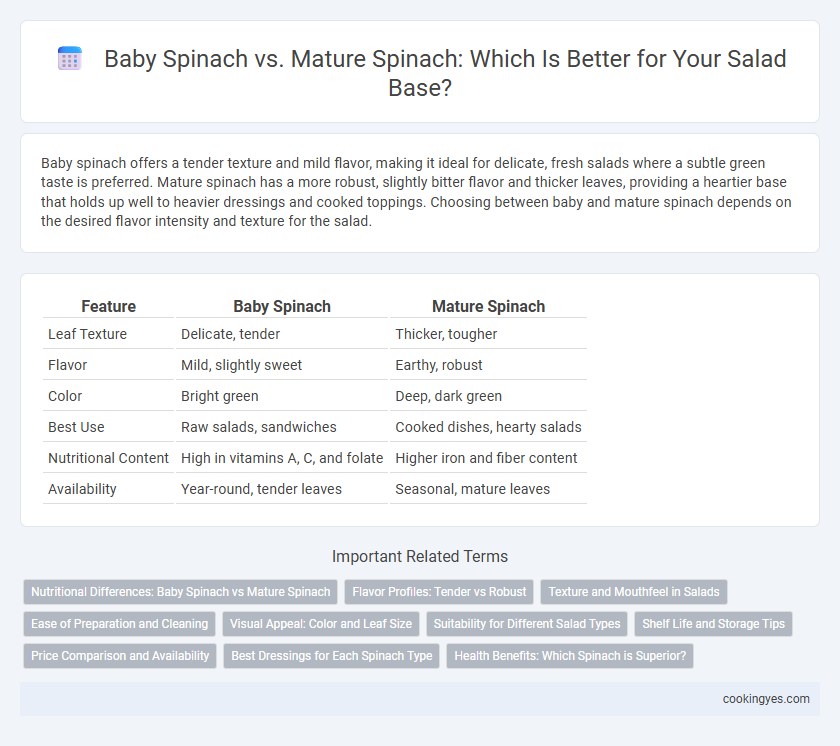Baby spinach offers a tender texture and mild flavor, making it ideal for delicate, fresh salads where a subtle green taste is preferred. Mature spinach has a more robust, slightly bitter flavor and thicker leaves, providing a heartier base that holds up well to heavier dressings and cooked toppings. Choosing between baby and mature spinach depends on the desired flavor intensity and texture for the salad.
Table of Comparison
| Feature | Baby Spinach | Mature Spinach |
|---|---|---|
| Leaf Texture | Delicate, tender | Thicker, tougher |
| Flavor | Mild, slightly sweet | Earthy, robust |
| Color | Bright green | Deep, dark green |
| Best Use | Raw salads, sandwiches | Cooked dishes, hearty salads |
| Nutritional Content | High in vitamins A, C, and folate | Higher iron and fiber content |
| Availability | Year-round, tender leaves | Seasonal, mature leaves |
Nutritional Differences: Baby Spinach vs Mature Spinach
Baby spinach contains higher levels of vitamin C and folate, making it ideal for boosting immune function and supporting cell growth. Mature spinach offers greater amounts of vitamin K and iron, which are essential for blood clotting and oxygen transport. Both forms provide dietary fiber, but mature spinach has a denser nutrient profile beneficial for bone health and anemia prevention.
Flavor Profiles: Tender vs Robust
Baby spinach offers a tender, mildly sweet flavor with a delicate texture, making it ideal for fresh salads and light dishes. Mature spinach delivers a robust, earthy taste and slightly firmer leaves, providing a more pronounced flavor that holds up well in cooked recipes or hearty salads. Choosing between baby and mature spinach depends on whether a subtle or intense spinach flavor is desired for the leafy base.
Texture and Mouthfeel in Salads
Baby spinach offers a tender, delicate texture with a mild, slightly sweet flavor, making it ideal for fresh, crisp salads that highlight a smooth mouthfeel. Mature spinach features thicker, more fibrous leaves with a robust, earthy taste that adds a hearty bite and chewy texture to mixed greens. Choosing between baby and mature spinach affects the salad's overall bite and freshness, with baby spinach enhancing softness and mature spinach providing a more substantial, textured experience.
Ease of Preparation and Cleaning
Baby spinach offers a clear advantage in ease of preparation and cleaning due to its tender leaves and minimal veins, requiring less trimming and washing compared to mature spinach. Mature spinach often contains thicker stems and larger leaves with more dirt trapped, necessitating thorough cleaning and de-stemming before using. Choosing baby spinach streamlines salad preparation, enhancing efficiency without compromising flavor or nutrient content.
Visual Appeal: Color and Leaf Size
Baby spinach offers vibrant, tender leaves with a bright green hue that enhances the visual appeal of salads, creating an inviting freshness. Mature spinach features larger, darker green leaves with a heartier texture, adding depth and a robust presence to salad bowls. Choosing between baby and mature spinach depends on the desired aesthetic, with baby spinach providing delicate color contrast and mature spinach delivering substantial leaf size for a bold leafy base.
Suitability for Different Salad Types
Baby spinach offers a tender texture and mild flavor, making it ideal for delicate salads with light dressings and fresh ingredients like strawberries or nuts. Mature spinach boasts a robust taste and firmer leaves, better suited for hearty salads with bold flavors, such as those including grilled meats or strong cheeses. Choosing between baby and mature spinach depends on the desired salad complexity and complementary ingredients for optimal taste and texture balance.
Shelf Life and Storage Tips
Baby spinach features a shorter shelf life of about 3 to 5 days when stored in the refrigerator, while mature spinach can last up to 7 days under optimal conditions. To extend freshness, store both types in a breathable container or perforated plastic bag, keeping them in the crisper drawer with minimal moisture to prevent wilting and decay. Properly drying the leaves before storage and avoiding overcrowding ensures maximum crispness and nutrient retention for both baby and mature spinach.
Price Comparison and Availability
Baby spinach tends to be more expensive than mature spinach due to its tender texture and higher demand in fresh salad mixes. Mature spinach is widely available year-round at lower prices, making it a cost-effective option for bulk use. Retailers frequently stock mature spinach in larger quantities, while baby spinach is often sold in smaller, premium packages.
Best Dressings for Each Spinach Type
Baby spinach's tender leaves pair exceptionally well with light, delicate dressings such as lemon vinaigrette or balsamic glaze, enhancing its mild flavor without overpowering it. Mature spinach, with its heartier texture and slightly bitter taste, complements robust dressings like creamy Caesar or Dijon mustard-based dressings that balance its earthiness. Choosing the right dressing tailored to the spinach type elevates the overall salad experience and highlights the unique qualities of each leaf.
Health Benefits: Which Spinach is Superior?
Baby spinach contains higher levels of vitamin C and antioxidants, promoting improved immune function and reduced oxidative stress compared to mature spinach. Mature spinach offers increased iron and fiber content, which support better digestion and enhanced blood health. Both forms provide essential nutrients, but baby spinach delivers superior antioxidant benefits, while mature spinach excels in mineral density.
Baby spinach vs Mature spinach for leafy base Infographic

 cookingyes.com
cookingyes.com